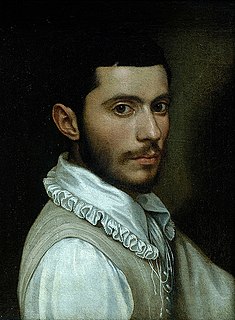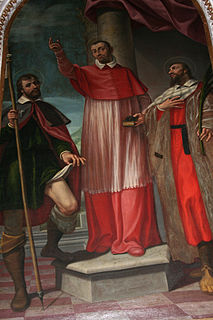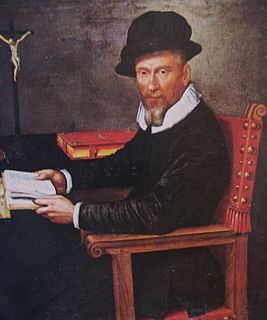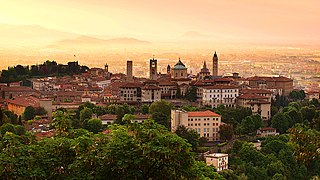
Lorenzo Lotto was an Italian painter, draughtsman and illustrator, traditionally placed in the Venetian school, though much of his career was spent in other North Italian cities. He painted mainly altarpieces, religious subjects and portraits. He was active during the High Renaissance and the first half of the Mannerist period, but his work maintained a generally similar High Renaissance style throughout his career, although his nervous and eccentric posings and distortions represented a transitional stage to the Florentine and Roman Mannerists.

Adrara San Martino is a comune in the province of Bergamo, in Lombardy, northern Italy.

Sebastiano Ricci was an Italian painter of the late Baroque school of Venice. About the same age as Piazzetta, and an elder contemporary of Tiepolo, he represents a late version of the vigorous and luminous Cortonesque style of grand manner fresco painting.

Scipione Pulzone, also known as Il Gaetano, was a Neapolitan painter of the late Italian Renaissance. His work differs in several respects from the Mannerist predominant at the time. He was active mainly in Rome, but also worked in Naples and Florence. It is thought that he studied under Jacopino del Conte in Rome.

Girolamo Siciolante da Sermoneta began his career as an Italian Mannerist painter but later adopted the reformist naturalism of Girolamo Muziano in the 1560s and 70s. He was active in Rome in the mid 16th century.

Andrea Fantoni (1659–1734) was an Italian sculptor and woodcarver of the late-Baroque period, active in the region near Bergamo.

Antonio Zanchi was an Italian painter of the Baroque, active mainly in Venice, but his prolific works can also be seen in Padova, Treviso, Rovigo, Verona, Vicenza, Loreto, Brescia, Milano, and Bergamo, as well as Bavaria.

Giovanni Paolo Cavagna was an Italian painter of the late-Renaissance period, active mainly in Bergamo and Brescia.

Andrea Previtali was an Italian painter of the Renaissance period, active mainly in Bergamo. He is also called Andrea Cordelliaghi.

Enea Salmeggia was an Italian painter of the late-Renaissance period, active mainly in his native city of Bergamo.

Francesco Rizzo da Santacroce, also known as simply Francesco da Santacroce or Francesco di Bernardo de' Vecchi Da Santa Croce was an Italian painter of the Renaissance period, active mainly in Bergamo and Venice.

Filippo Abbiati (1640–1715) was an Italian painter of the early-Baroque period, active in Lombardy and Turin, together with Andrea Lanzani and Stefano Maria Legnani, he was a prominent mannerist painters from the School of Lombardy. Born in Milan, he was a pupil of the painter Antonio Busca. Alessandro Magnasco was one of his pupils along with Pietro Maggi and Giuseppe Rivola. Ticozzi claims he trained, along with Federigo Bianchi, with Carlo Francesco Nuvolone. Along with Bianchi, he painted the cupola of Sant'Alessandro Martire in Milan. Abbiati also painted a St. John preaching in the Wilderness for a church in Saronno.
Giovanni Giacomo Barbelli was an Italian painter of the Baroque period, active in Brescia.

Agostino de Fondulis was an Italian sculptor and architect active in Lombardy.

The church of San Macuto is a church on Piazza di San Macuto in the Colonna rione of Rome, Italy. Located next to the Jesuit Collegio di San Roberto Bellarmino in the Palazzo Gabrielli-Borromeo, it is the only church in Italy dedicated to the Breton saint Malo.

Francesco Zucco was an Italian painter.

Giovanni Battista Parodi (1674–1730) was an Italian painter, born in Genoa. He belonged to an Italian family of artists. His father was the sculptor and wood-carver Filippo Parodi (1630–1702). His brother was Domenico Parodi (1672–1742), a painter, sculptor and architect.

San Bernardino in Pignolo is a Roman Catholic church located on Via Pignolo #59, in Bergamo, region of Lombardy, Italy.
Anton Maria Pirovano was an Italian sculptor, painter, and architect, active in a late baroque style, around Bergamo in the region of Lombardy.
The Museo Adriano Bernareggi, also called the Museo Diocesano Bernareggi is an gallery of sacred art and objects housed in a former aristocratic palace, the Palazzo Bassi-Rathgeb, located on Via Pignolo #76 in Bergamo, Italy. The museum is presently managed by the Fondazione Adriano Bernareggi in conjunction with the Università degli Studi di Bergamo, and displays eclectic works of art from the 15th-century to present, often paired, and derived mainly from the Bernareggi family, as well as the Diocese of Bergamo.



















